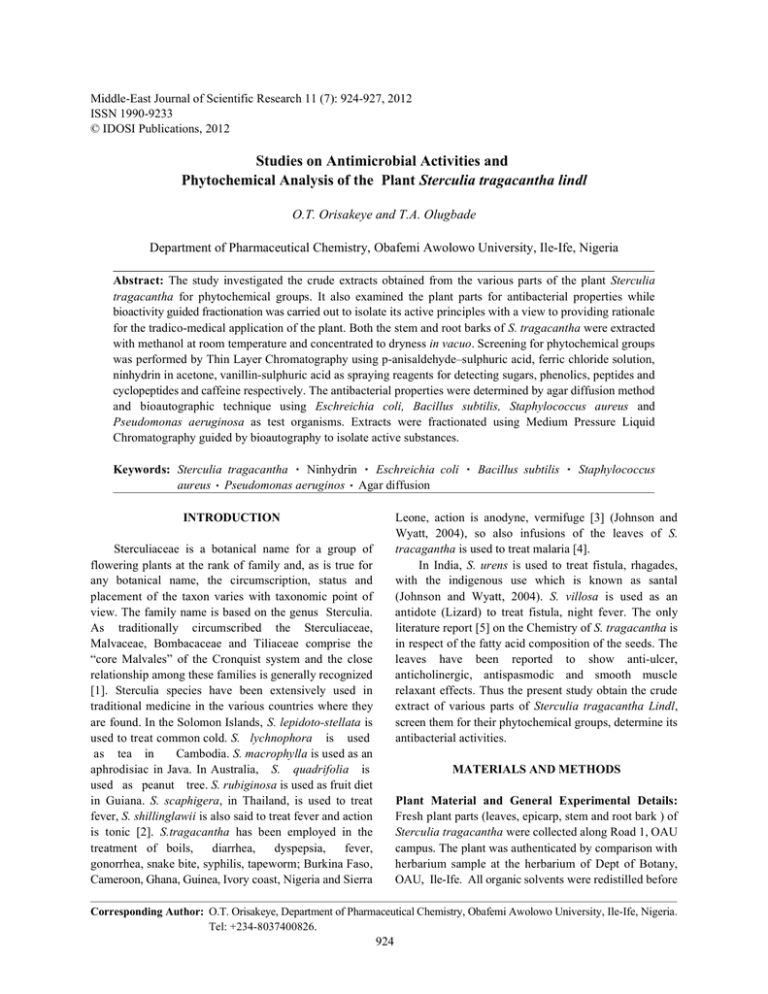Middle-East Journal of Scientific Research 11 (7): 924-927, 2012 ISSN 1990-9233
advertisement

Middle-East Journal of Scientific Research 11 (7): 924-927, 2012 ISSN 1990-9233 © IDOSI Publications, 2012 Studies on Antimicrobial Activities and Phytochemical Analysis of the Plant Sterculia tragacantha lindl O.T. Orisakeye and T.A. Olugbade Department of Pharmaceutical Chemistry, Obafemi Awolowo University, Ile-Ife, Nigeria Abstract: The study investigated the crude extracts obtained from the various parts of the plant Sterculia tragacantha for phytochemical groups. It also examined the plant parts for antibacterial properties while bioactivity guided fractionation was carried out to isolate its active principles with a view to providing rationale for the tradico-medical application of the plant. Both the stem and root barks of S. tragacantha were extracted with methanol at room temperature and concentrated to dryness in vacuo. Screening for phytochemical groups was performed by Thin Layer Chromatography using p-anisaldehyde–sulphuric acid, ferric chloride solution, ninhydrin in acetone, vanillin-sulphuric acid as spraying reagents for detecting sugars, phenolics, peptides and cyclopeptides and caffeine respectively. The antibacterial properties were determined by agar diffusion method and bioautographic technique using Eschreichia coli, Bacillus subtilis, Staphylococcus aureus and Pseudomonas aeruginosa as test organisms. Extracts were fractionated using Medium Pressure Liquid Chromatography guided by bioautography to isolate active substances. Keywords: Sterculia tragacantha Ninhydrin Eschreichia coli aureus Pseudomonas aeruginos Agar diffusion INTRODUCTION Bacillus subtilis Staphylococcus Leone, action is anodyne, vermifuge [3] (Johnson and Wyatt, 2004), so also infusions of the leaves of S. tracagantha is used to treat malaria [4]. In India, S. urens is used to treat fistula, rhagades, with the indigenous use which is known as santal (Johnson and Wyatt, 2004). S. villosa is used as an antidote (Lizard) to treat fistula, night fever. The only literature report [5] on the Chemistry of S. tragacantha is in respect of the fatty acid composition of the seeds. The leaves have been reported to show anti-ulcer, anticholinergic, antispasmodic and smooth muscle relaxant effects. Thus the present study obtain the crude extract of various parts of Sterculia tragacantha Lindl, screen them for their phytochemical groups, determine its antibacterial activities. Sterculiaceae is a botanical name for a group of flowering plants at the rank of family and, as is true for any botanical name, the circumscription, status and placement of the taxon varies with taxonomic point of view. The family name is based on the genus Sterculia. As traditionally circumscribed the Sterculiaceae, Malvaceae, Bombacaceae and Tiliaceae comprise the “core Malvales” of the Cronquist system and the close relationship among these families is generally recognized [1]. Sterculia species have been extensively used in traditional medicine in the various countries where they are found. In the Solomon Islands, S. lepidoto-stellata is used to treat common cold. S. lychnophora is used as tea in Cambodia. S. macrophylla is used as an aphrodisiac in Java. In Australia, S. quadrifolia is used as peanut tree. S. rubiginosa is used as fruit diet in Guiana. S. scaphigera, in Thailand, is used to treat fever, S. shillinglawii is also said to treat fever and action is tonic [2]. S.tragacantha has been employed in the treatment of boils, diarrhea, dyspepsia, fever, gonorrhea, snake bite, syphilis, tapeworm; Burkina Faso, Cameroon, Ghana, Guinea, Ivory coast, Nigeria and Sierra MATERIALS AND METHODS Plant Material and General Experimental Details: Fresh plant parts (leaves, epicarp, stem and root bark ) of Sterculia tragacantha were collected along Road 1, OAU campus. The plant was authenticated by comparison with herbarium sample at the herbarium of Dept of Botany, OAU, Ile-Ife. All organic solvents were redistilled before Corresponding Author: O.T. Orisakeye, Department of Pharmaceutical Chemistry, Obafemi Awolowo University, Ile-Ife, Nigeria. Tel: +234-8037400826. 924 Middle-East J. Sci. Res., 11 (7): 924-927, 2012 use. Different phytochemical groups was screened by using Thin Layer Chromatography spots detection. Antimicrobial properties was determined using both bioautographic technique (Tlc) and agar diffusion. Anticholinesterate activity was determined using tlc bioautographic technique. Tlc Spot Detection: Spots were detected by viewing under ultraviolet (uv) light (254 and 366 nm wavelength). Spraying reagents used for detection on thin-layer chromatographic plates are as follows: -Anisaldehyde-sulphuric acid p It is used in the detection of sugars. The solution is freshly prepared, 1ml p-anisaldeyde, 1ml 97% sulphuric acid in 18ml ethanol, for spraying on TLC plates. plate was laid flat on plastic plugs in a plastic tank containing a little water; by this means, water did not come directly into contact with the plate but the atmosphere was kept humid. The cover was placed on the tank and incubation was performed at room temperature for 20min. The enzyme had satisfactory stability under these conditions. For detection of the enzyme, solutions of 1-naphtyl acetate (250 mg) in ethanol (100 mL) and of Fast Blue B salt (400 mg) in distilled water (160 mL) were prepared immediately before use (in order to prevent decomposition). After incubation of the TLC plate, 10 mL of the naphthyl acetate solution and 40 ml of the Fast Blue B salt solution were mixed and sprayed onto the plate to give a purple coloration after 1-2min with active spots appearing decolourised. Antimicrobial Screening: The agar diffusion (cup plate) method was used for this examination. Molten and cooled agar 60 mL (45°C) were separately inoculated with the nutrient broth culture of the test organisms (0.6 mL) and mixed thoroughly. The inoculated medium was then carefully poured into sterile Petri dishes (24 cm Petri dish) and allowed to set. Thereafter, cups (9 mm diameter) were aseptically bored into the solid nutrient agar using a sterile cork borer. The test solutions 100 L each were then introduced into each of the cups ensuring that no spillage occurred. Also the same volume of the standard antimicrobial agent and the solvent were introduced into some of the cups to act as positive and negative controls respectively. The plates were left at room temperature for 2 hours to allow for diffusion into the medium and thereafter incubated face upwards at 37°C for 24 hours. Sample was tested in duplicate and the diameters of zone of inhibition were measured to the nearest millimeter using a transparent ruler. Ferric Chloride: It is used in the detection of phenolics. A solution of FeCl3 (1g) in methanol (40ml) is prepared for spraying on TLC plates. Ninhydrin/Acetone: It is used in the detection of peptides. A solution of 1g ninhydrin in 100ml acetone is freshly prepared for spraying on TLC plates. Vanillin/Sulphuric Acid: A solution of 1g of vanillin in 100ml of sulphuric acid is prepared for spraying on TLC plates. Bioautography Techniquefor Anti-microbial Screening: The method involved an overlay of inoculated agar medium on developed silica gel tlc glass plates followed by incubation at 37°C for 24h. After incubation and revelation with tetrazolium salt, inhibition zones are visible as decolorized spots against purple background. Test for Peptides: The extracts were examined for presence of peptides using TLC technique with solvent system Q as the mobile phase. A reverse phase plate was the stationary phase while freshly prepared ninhydrin in acetone was the detecting agent. Presence of cyclopeptides was studied in the crude extract by developing two spotted silica plates (A and B) in solvent system Q. Sample on one of the plates (B) was hydrolyzed by heating the plate in a covered glass vessel containing concentrated hydrochloric acid at 100°C for 1h. Both plates (A and B) were subsequently sprayed with ninhydrin in acetone. Any ninhydrin positive spot on B but absent in A is taken as positive for the presence of cyclopeptides. Bioautography Technique for Anticholinesterate Screening: Acetylcholinesterase (1000U) was dissolved in 150ml of 0.05M Tris-hydrochloric acid buffer at pH 7.8; bovine serum albumin (150mg) was added to the solution in order to stabilize the enzyme during the bioassay. The stock solution was kept at 4°C. TLC plates were eluted with acetone in order to wash them and were thoroughly dried just before use. After migration of the sample in a suitable solvent, the TLC plate was dried with a hair dryer for complete removal of solvent. The plate was then sprayed with enzyme stock solution and thoroughly dried again. For incubation of the enzyme, the 925 Middle-East J. Sci. Res., 11 (7): 924-927, 2012 Test for Sugars: A solution of the test material was spotted on the tlc plate along side with glucose, sucrose, fructose, lactose and developed using a suitable solvent system. This was sprayed with P-anisaldehyde-sulphuric acid. Table 1: Screening of crude extracts for phytochemical groups Xanthine alkaloid STE STL STRB STSB Test for Caffeine: A solution of the test material was spotted on the tlc plate along side with Caffeine. This was sprayed with vanillin/sulphuric acid. Peptides - Phenolics + - + + + Cyclopeptides Sugars + + - (-) = absent, (+) = present Table 2: Antimicrobial activities of the crude extract of Sterculia tragacantha in 80mg/ml in 50% methanol Test Organisms Extraction Preparation of Plant Material for Preliminary Studies: The individual parts of the plant were chopped and macerated, or dried and milled before extraction in methanol for 48h. These were then filtered and the filtrates were evaporated to dryness in vacuo. Then it was subsequently subjected to various chromatographic techniques and guided by bioautographic technique to monitor its phytochemical groups and anti-bacterial activities. Escherichia coli NCTC 10418 Staphylococcus aureus NCTC 6571 Pseudomonas aeruginosa ATCC 10145 Bacillus subtilis NCTC 8236 STRB STSB 5 6 5 7 SOLVENT - Cup size = 8.0mm - =No activity RESULTS AND DISCUSSION Screening of Crude Extracts for Phytochemical Groups, Antimicrobial Activities: Crude extracts of plant parts (STE-S.tragacantha epicarp, STL-S.tragacantha leaf, STRB-S.tragacantha root bark, STSB- S.tragacantha stem bark were screened for phytochemical groups to give results as summarized in Table 1, for antimicrobial activities as presented in Table 2. Plate 1: Bioautography technique of fraction C and E of S. tragacantha using B. substillis as test organism S. tragacantha root bark, stem bark and epicarp showed the presence of phenols. Screening for Phytochemical Groups: The phytochemical screening of the plant parts of S.tragacantha showed no presence of caffeine in any of the plant parts tested. This is interesting in view of the presence of these alkaloids in the genera Cola and Theobroma. All the various parts of the plant were screened for peptides. Only Sterculia tragacantha root bark showed the presence of peptides. Out of all the various parts of the plant screened for cyclopeptides, S.tragacantha epicarp and S.tragacantha stem bark showed the presence of cyclopeptides. Unlike the case of peptides, cyclopetides are detectable with ninhydrin only after hydrolyses, since the detection involve reaction of ninhydrin with the free primary amino function. However, amides are expected to show similar characteristics as the cyclopeptides in the test system. No sugars were detected in the all the parts of the plant of S.tragacantha. Antimicrobial Screening of Crude Extracts of S.tragacantha: In this study, various parts of the S. tragacantha were subjected to preliminary antimicrobial tests. The result showed that the crude extracts of S. tragacantha root bark and S. tragacantha stem bark were active against gram-positive organisms (S. aureus and B. subtilis) but inactive against gramnegative organisms (E. coli and Ps. aeruginosa) (Table 2). Antimicrobial Screening of Fractions C and E from Vacuum Chromatography of S.tragacantha Stem Bark Extracts: Fractions C and E eluted from EtOAc:CH3OH (190:10) and EtOAc:CH3OH(180:20) respectively showed activity using B.subtilis as the test organism. The active spots decolourised against purple colouration background on bioautography technique (as shown in the plate 1) 926 Middle-East J. Sci. Res., 11 (7): 924-927, 2012 Anticholinesterase Screening of Crude Extracts of S.tragacantha: The crude extracts of the various parts did not show any anti-cholinesterase activity. So no further test was done on the fractions. REFERENCES 1. 2. CONCLUSION The crude extract of both the stem and root bark of S.tragacantha demostrated activity against Staphylococcus aureus and Bacillus subtilis in the agar diffusion test system for the first time. The further fractionated extracts also showed strong anti-bacterial property in the bioautographic test system for the first time. It also showed the presence of phenols. The demostration of the antimicrobial activity validates the ethnomedicinal use of the plant in the treatment of boils, diarrhea, gonorrhea, etc. 3. 4. 5. ACKNOWLEDGEMENT Thanks to Mr. Adaramola (Retired), of the Department of Botany, Obafemi Awolowo University, Ile-Ife, Nigeria. Support provided by the International Programme in the Chemical Sciences (IPICS), Uppsala, Sweden through the Nig. 01 project is duly acknowledged. Thanks also to my supervisor Prof. T.A. Olugbade, Dean, Faculty of Pharmacy, OAU, Ile-Ife. 927 Watson, L. and M.J. Dallwitz, 1992. Angiosperm Families-Sterculiaceae vent. Chemical Pharmaceutical J., 38: 23-28. Irvine, F.R., 1961. Woody Plants of Ghana: With special reference to their uses. Oxford University Press, London. pp: 508- 575. Dennis, F., G.T. Odamtten, T. Agbovie, K. Amponsah and O.R. Crentsil, 2002. Conservation and sustainable use of medicinal plants in Ghana. African J. Infectious Dis., 2(38): 213-215. Coles, M., 1981. Study of medicinal plants in Gloucester village, Ph.D thesis, Department of Botany, University of Sierra Leone, Sierra Leone. Gaydou, M.E., A.R.P. Ramanoelina, J.R.E Rasoarahona and A. Combres, 1993. Fatty acid composition of Sterculia seeds and oils from Madagascar. J. Agricultural and food Chemistry, 41: 64-66.




